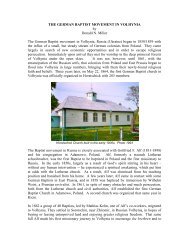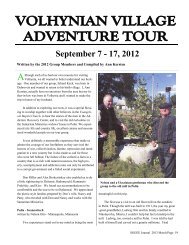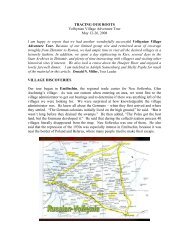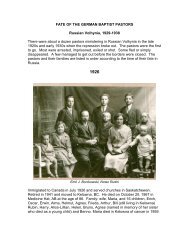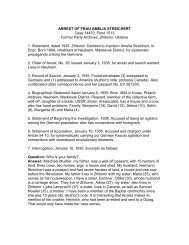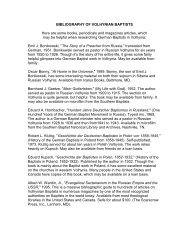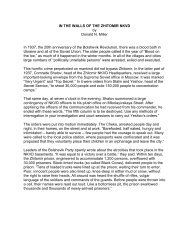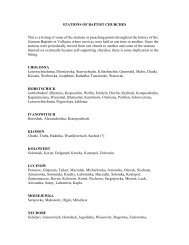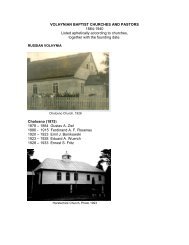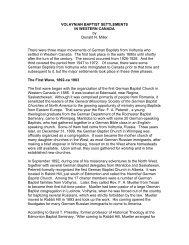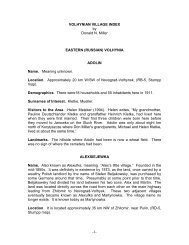«Abendt», «Maria» «Johann» - Volhynia
«Abendt», «Maria» «Johann» - Volhynia
«Abendt», «Maria» «Johann» - Volhynia
Erfolgreiche ePaper selbst erstellen
Machen Sie aus Ihren PDF Publikationen ein blätterbares Flipbook mit unserer einzigartigen Google optimierten e-Paper Software.
hardships and deprivations along the way, many people fell victim to hunger,<br />
sickness, especially typhoid fever, and death. Many children were born in<br />
wagons and boxcars and the dead were hurriedly buried by the side of the road.<br />
The deportees were transported over many thousands of km and eventually<br />
unloaded in Siberia, Central Asia and the Ural region, although some were<br />
allowed to settle in Ukraine and Russia, some miles from home. In their new<br />
and strange environment they were required to work at a variety of jobs in order<br />
to survive. Most of them fared badly, but with the fall of the Tsarist government<br />
in 1917, they soon began trickling back home. The majority returned in 1918,<br />
though some did not make it back until 1920 and later. No sooner was one war<br />
finished than another began. It was called the Civil War between the Whites and<br />
the Reds. During this time the <strong>Volhynia</strong>ns were caught in the in-fighting and had<br />
to defend themselves as there was no longer any authority. At the same time the<br />
<strong>Volhynia</strong>ns were often caught in the chaotic upheavals between the newly<br />
resurrected Poland and Russia.<br />
(Excerpt from the book The Old Country by Donald N. Miller)<br />
LIST OF LAND EXPROPRIATED<br />
The list of those whose land was to be expropriated originally appeared in the<br />
Volhyn’s Gubernia News (No. 56) on June 2, 1916. It is important to remember<br />
that this is a land expropriation listing, not a deportation listing, although most, if<br />
not all of the people whose land was taken away from them, were eventually<br />
deported. Even then the list is not 100% complete or accurate, as a number of<br />
discrepancies in the various newspaper listings have been found. Some<br />
corrections of the most obvious errors have been made in this listing. The list<br />
has also been culled of duplicate and undecipherable names. Also, only the<br />
landowners or their heirs are listed, not renters, which means that there were<br />
many more German colonists living within these boundary zones when the law<br />
took effect than what is found here.<br />
This lists identifies the name of the head of the family, including the patronymic<br />
name (father’s name), and the family name. In the original newspaper article, the<br />
name of the village where the land was located and the amount of land<br />
expropriated is also given. In 1993 I originally obtained the listing of the<br />
landowners in the newspaper from the State Archives in Zhitomir and made it<br />
available to the American Historical Society of Germans from Russia in Lincoln,<br />
Nebraska. It was subsequently was translated by Brent Alan Mai of Purdue<br />
University (1997). It should be noted that where a name is not certain, it is<br />
followed by a single question mark. (Editor’s note: The listing of names is used<br />
by permission of AHSGR and Brent Mai, May 2005).



